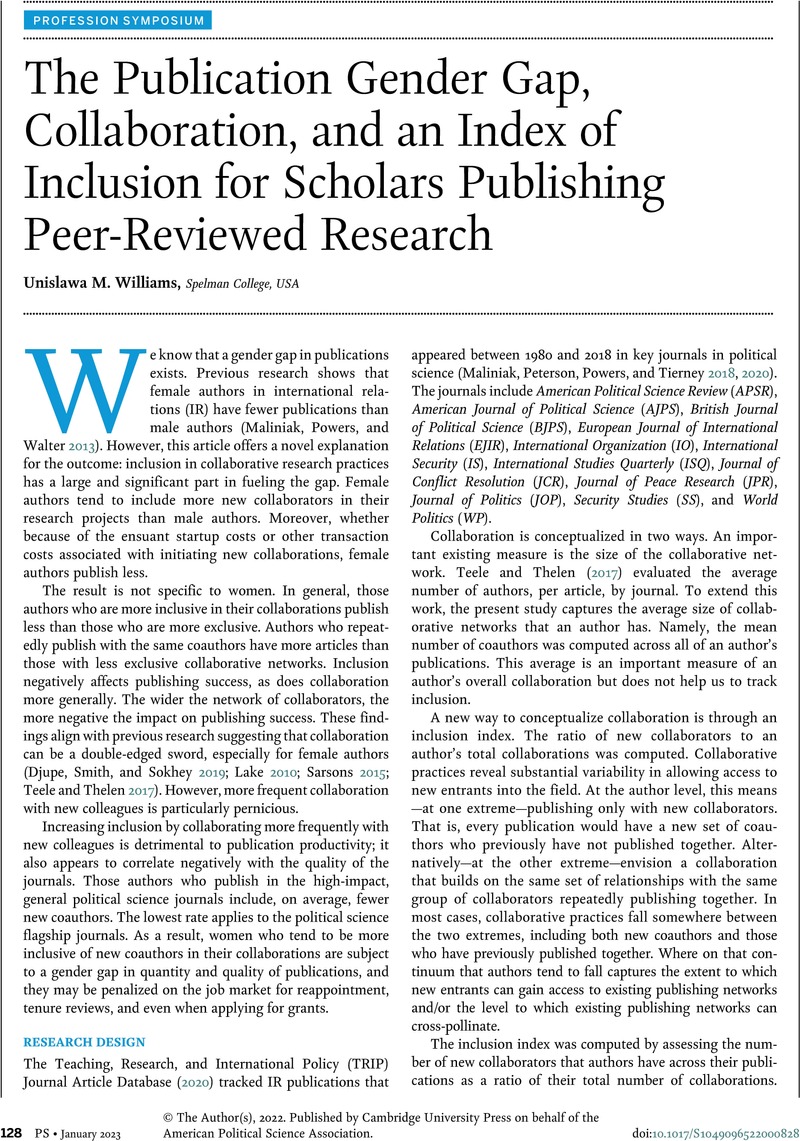No CrossRef data available.
Article contents
The Publication Gender Gap, Collaboration, and an Index of Inclusion for Scholars Publishing Peer-Reviewed Research
Published online by Cambridge University Press: 05 October 2022
Abstract
An abstract is not available for this content so a preview has been provided. Please use the Get access link above for information on how to access this content.

- Type
- Structuring Inclusion into Political Science Recruiting, Progression, and Engagement
- Information
- Copyright
- © The Author(s), 2022. Published by Cambridge University Press on behalf of the American Political Science Association
References
REFERENCES
Appleton, Andrew, and Mazur, Amy. 2006. “Making International Collaboration Work: An Update from the French Politics Group of APSA.” PS: Political Science & Politics 39 (2): 389–91.Google Scholar
Biggs, Jeffrey. 2008. “Allocating the Credit in Collaborative Research.” PS: Political Science & Politics 41 (1): 246–50.Google Scholar
Bleck, Jaimie, Dendere, Chipo, and Sangaré, Boukary. 2018. “Making North–South Research Collaborations Work.” PS: Political Science & Politics 51 (3): 554–58.Google Scholar
Butler, Daniel M., Butler, Richard J., and Rich, Jesse T.. 2008. “The Equalizing Effect of the Internet on Access to Research Expertise in Political Science and Economics.” PS: Political Science & Politics 41 (3): 579–84.Google Scholar
Djupe, Paul A., Smith, Amy Erica, and Sokhey, Anand Edward. 2019. “Explaining Gender in the Journals: How Submission Practices Affect Publication Patterns in Political Science.” PS: Political Science & Politics 52 (1): 71–77.Google Scholar
Frasure-Yokley, Lorrie, Wong, Janelle, Vargas, Edward, and Barreto, Matt. 2020. “The Collaborative Multiracial Post-Election Survey (CMPS): Building the Academic Pipeline Through Data Access, Publication, and Networking Opportunities.” PS: Political Science & Politics 53 (1): 150–51.Google Scholar
Herrick, Skye, Matthias, William, and Nielson, Daniel. 2015. “How Collaborations with Undergraduates Improve Both Learning and Research: With Examples from International Development Experiments.” PS: Political Science & Politics 48 (1): 48–52.Google Scholar
King, Gary, Kuriwaki, Shiro, and Park, Yon Soo. 2020. “The ‘Math Prefresher’ and the Collective Future of Political Science Graduate Training.” PS: Political Science & Politics 53 (3): 537–41.Google Scholar
Lake, David A. 2010. “Who’s on First? Listing Authors by Relative Contribution Trumps the Alphabet.” PS: Political Science & Politics 43 (1): 43–47.Google Scholar
Maliniak, Daniel, Peterson, Susan, Powers, Ryan, and Tierney, Michael J.. 2018. “Is International Relations a Global Discipline? Hegemony, Insularity, and Diversity in the Field.” Security Studies 27 (3): 448–84.CrossRefGoogle Scholar
Maliniak, Daniel, Peterson, Susan, Powers, Ryan, and Tierney, Michael J.. 2020. “TRIP Journal Article Database Codebook, Version 2.2.” Teaching, Research, and International Policy Project. Williamsburg, VA: Global Research Institute.Google Scholar
Maliniak, Daniel, Powers, Ryan, and Walter, Barbara. 2013. “The Gender Citation Gap in International Relations.” International Organization 67 (4): 889–922.Google Scholar
Mazur, Amy. 2005. “APSA–PSA (UK) Collaborate over French Politics.” PS: Political Science & Politics 38 (1): 162–62.Google Scholar
McDermott, Rose. 2010. “Data Collection and Collaboration.” PS: Political Science & Politics 43 (1): 15.Google Scholar
McDermott, Rose, and Hatemi, Peter K.. 2010. “Emerging Models of Collaboration in Political Science: Changes, Benefits, and Challenges.” PS: Political Science & Politics 43 (1): 49–58.Google Scholar
R Core Team. 2013. “R: A Language and Environment for Statistical Computing.” Vienna, Austria: R Foundation for Statistical Computing. www.R-project.org.Google Scholar
Rodriguez, German. 2020. “R Logs: Models of Over-Dispersed Count Data.” https://data.princeton.edu/wws509/r/overdispersion.Google Scholar
Sarsons, Heather. 2015. “Gender Differences in Recognition for Group Work.” Cambridge, MA: Harvard Economics Department. Working Paper, December 3.Google Scholar
Sigelman, Lee. 2009. “Are Two (or Three or Four…or Nine) Heads Better than One? Collaboration, Multidisciplinarity, and Publishability.” PS: Political Science & Politics 42 (3): 507–12.Google Scholar
Sinmazdemir, Tolga. 2019. “Collaborating across Borders: Challenges and Choices in Joint Survey Research between Local and Foreign Scholars.” PS: Political Science & Politics 52 (3): 503–6.Google Scholar
Teaching, Research, and International Policy Project. 2020. “TRIP Journal Article Database Release, Version 3.3.” https://trip.wm.edu/data/dashboard/journal-article-database.Google Scholar
Teele, Dawn Langan, and Thelen, Kathleen. 2017. “Gender in the Journals: Publication Patterns in Political Science.” PS: Political Science & Politics 50 (2): 433–47.Google Scholar
Wildavsky, Aaron. 1986. “On Collaboration.” PS: Political Science & Politics 19 (2): 237–48.Google Scholar


